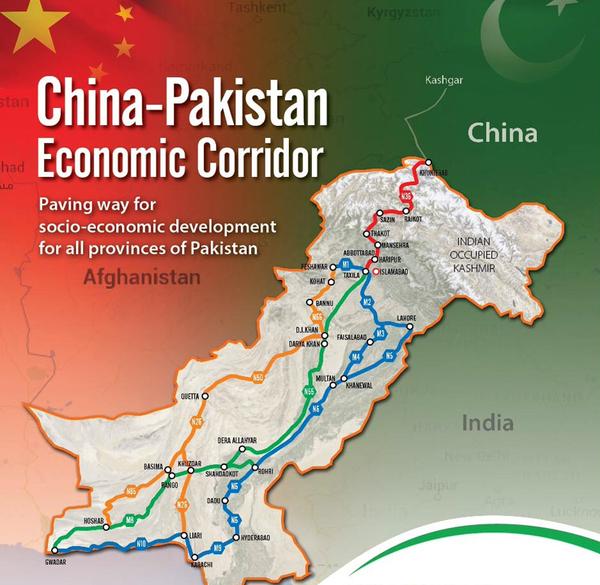
by Irfan Mahar 21 May 2020
April 2015, was a historic month for the Sino-Pakistan relations when China and Pakistan signed an agreement worth $46 billion for the China-Pakistan Economic Corridor That with the passage of time increased and reached $62 billion. The time tested, and deep-rooted Sino-Pak relations would go down into the annals of history as an everlasting era of bilateral bonding and mutual trust. This high significance corridor runs through one of the most vital geostrategic locations in South Asia. As far as the first phase of CPEC is concerned, the recent statistics show that it is going satisfactory in which Pakistan has completed some significant energy projects. Now Islamabad aims to improve its transmission system so that it can cut down on the outages. Similarly, infrastructure projects such as motorways are going well.
According to ISPR Official Documentary on the progress of CPEC, the multi-beneficial CPEC opened for trade purposes on October 2016. On that date, a convoy of 95 trucks left the Sust dry port for their journey across the CPEC right up to Gwadar Port. Besides, Pakistan Army and other law enforcement agencies made full proof security arrangements for safe transportation of these trucks along the CPEC. Also, the safe passage of these convoys to Gwadar is a hallmark to the untiring efforts of the government of Pakistan and Pakistan Army. Besides, the success has not come up easy today while passing through the Khunjrab Pass where the altitude reached 4700 meters, one reminded of 800 Pakistan Army and 300 Chinese engineers were laid their lives for this dream to come true. After the successful completion of phase one Pakistan is going into phase two which is going to be industrialization, modernization of agriculture, livelihoods, the concentration of special economic zones, and relocation of industry especially labour-intensive costs are going up.
Concerning the success of CPEC, many scholars, writers, and experts shared their views such as Former Amb. Abdul Razak Daood, a Foreign Minister Shah Mahmood Qureshi, said that CPEC headed in the right direction and it is not a debt trap instead of a project of peace, prosperity, development and job creation for Pakistan. Meanwhile, Saad Hashmi, Economy Expert at Topline Securities, expressed that CPEC was not going to become a debt trap for Pakistan rather a game-changer through its progress and stability. He further argued that when Islamabad would spend all that money in power projects, infrastructure and industries resultantly the GDP growth of Pakistan would improve on that bases Islamabad could quickly return its loans. Such as, Neelum-Jhelum Plant (a largest overseas hydropower project) that provides 500 million kWh of electricity a year, this will alleviate 15% of power shortfall in Pakistan along with generating Rs45 billion or $400 million.
When it comes to the criticism over CPEC as a debt trap by the countries such as the US and India, their disparagement does not base on facts rather personal grudges with Islamabad and Beijing. As US assistant secretary for South Asia, Alice Wells criticized that project and called it debt trap, but both Pakistan and China denied her allegations. In this regard, the Planning Commission of Pakistan told that “the debt repayments will start in 2021 with about $300-400 million annually and gradually peak to about $3.5 billion by the fiscal year 2024-25 before tapering off with total repayments to be completed in 25 years.” It further explained that “CPEC is not imposing any immediate burden concerning loans repayment and energy sector outflows.” It shows that Islamabad can return its loans from the benefits of the investment to the economy of Pakistan. Besides, CPEC is “an engine for economic growth and expects to increase Pakistan’s GDP growth by 2 to 3pc.” That is why CPEC is considered not a ‘debt-trap but a boon for Pakistan. If China lends money to Pakistan at one of the lowest interest rates in the world, how can it be a debt-trap?
On 23rd of July 2018, a statement by the Chinese Embassy in Pakistan showed that CPEC had achieved significant progress in the last five years. It further explained that “CPEC has effectively alleviated energy crisis and infrastructure shortage that Pakistan considers as two bottlenecks in its development, and played a positive role in maintaining the relatively high economic growth in the country.” Also, Noor Ahmed, secretory of the Economic Affairs Division of Pakistan, told that share of Chinese loan is about 10 per cent of total foreign debt while the country’s total external debt is about $106 billion. Meanwhile, the remaining 89-90 per cent foreign debt is from the International Monetary Fund (IMF), Paris Club, and other western organizations.
According to the Ministry of Planning, Development and Reform, CPEC has so far created 75,000 direct jobs, and it has the potential to further generate 800,000 to 1,500,000 posts till 2030. The progress of the CPEC projects portrays that it is going to be beneficial for Pakistan instead of a debt trap. Such as Yao Jing, Chines Ambassador to Pakistan, expressed his views by saying “Beijing would only proceed with projects that Pakistan wanted, this is Pakistan’s economy, this is their society.” Pakistan has to return the Chinese loans by 2037-38 that is much time, and Islamabad could quickly generate massive money from the completed projects, in this regard, it will be feasible for it to return its loans from the profits of successful projects under CPEC. These projects aim to generate a considerable amount of money resultantly strengthening the economy and GDP of Pakistan.
The writer is PhD scholar in the Department of Defense and Strategic Studies, Quaid-i-Azam University Islamabad, Pakistan.
